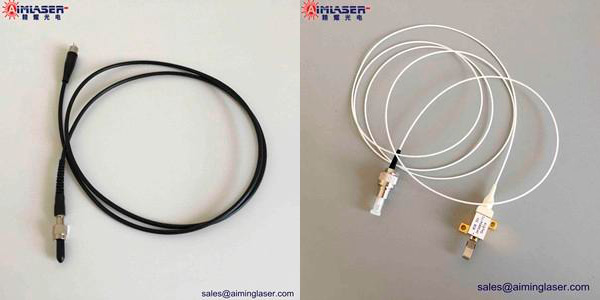There are many types of jumper and pigtail. The main difference between jumper and pigtail is that only one end of pigtail has a connector, while two jumpers there are connectors at each end. Generally speaking, the jumper is cut off from the middle to be two tail fibers. Jumpers are cables directly connected to desktop computers or equipment to facilitate the connection and management of equipment. Jumpers have a thick protective layer and are often used between terminal boxes and optical terminals. Only one end of the tail fiber has a connector, and the other end is an optical fiber connector, which is connected with other optical fiber cores in the form of fusion, and generally appears in the optical fiber terminal box.

Jumpers are generally distinguished by single mode and multimode in data transmission equipment. Single mode jumpers are usually yellow in color and have two wavelengths. 1310nm and 1550nm respectively, and the transmission distances are 10km and 40km; respectively; the multimode jumper is usually orange in color, with a wavelength of 850nm and a transmission distance of 500m m. According to the type of connector, it can be divided into the following types: FC jumper: round optical fiber connector, reinforced by additional metal sleeve, and fixed by turnbuckle. SC jumper: Rectangular connector, fixed by pin-bolt type, without rotation. Type-ST jumper: round connector, with clamping connection, fixed by turnbuckle. LC jumper: square connector, fixed by modular jack (RJ) latch principle which is easy to operate.
The types of pigtail mainly include single-core pigtail, double-core pigtail, 4-core pigtail, 12-core pigtail, 12-color pigtail and SC. Bundle pigtail, FC bundle pigtail, LC bundle pigtail and ST bundle pigtail. Besides these, it can also be divided into the following types: bundle tail fiber: this kind of tail fiber is also called tail fiber bundle, which is composed of Corning tight-sleeved optical fiber, aramid fiber reinforced element and flame retardant PVC protective sleeve. Compared with other kinds of tail fibers, it is more popular and widely used. Ribbon pigtail: Ribbon pigtail is the same as bundle pigtail, both of which belong to multi-core pigtail. Ribbon pigtail contains 12 optical fibers, one end of which is used for welding, and the other end is equipped with a connector. Armored tail fiber: The outermost layer of this kind of tail fiber is added with a layer of metal protective sleeve compared with the conventional tail fiber, so it is more durable than the conventional tail fiber. Fiber pigtail: low insertion loss, high return loss, good interchangeability and repeated unplugging, so it is very convenient to use. Waterproof tail fiber: with dense protective sleeve and waterproof sealing joint, suitable for harsh environment.
Jumpers are mainly used to connect optical fiber distribution frames or optical fiber information sockets to switches and switches to switches. The connection between switches and desktop computers and the connection between optical fiber information sockets and desktop computers can be applied. In the management, equipment room and workspace subsystem. Tail fiber is mainly used in optical fiber communication system, optical fiber access network, optical fiber data transmission, optical fiber CATV, local area network (LAN), test equipment, optical fiber sensor, serial server, FTTH/FTTX, telecommunication network and pre-termination installation.
First, the sending and receiving wavelengths of the optical modules connected by jumpers must be the same. Generally, the short-wave optical modules are matched with multimode jumpers, and the long-wave ones. With single-mode jumper of optical module, to ensure the accuracy of data transmission.
Second, the winding of the jumper in the wiring process is reduced as much as possible, which can reduce the attenuation of the optical signal in the transmission process.
Third, the connector of jumper should be kept clean, and the connector should be sealed with a protective sleeve after use to prevent oil stains and dust from entering. If you get a stain, use a cotton swab dipped in alcohol to clean it.
Fourth, the tail fiber is slender, and its cross section is at an angle of 8 degrees. It is not resistant to high temperature, and it will be damaged when it exceeds 100℃, so it should be avoided.